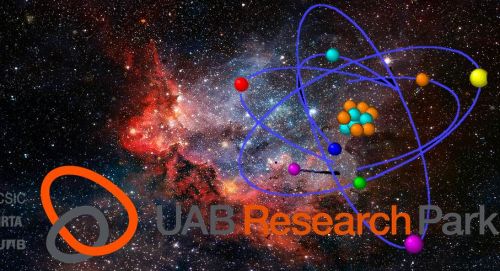
26/07/2017
The UAB Research Park: from the infinitely small to the infinitely big
The UAB Research Park: from the infinitely small to the infinitely big
The UAB Research Park (PRUAB), of which the Barcelona Synchrotron Park is a partner and sponsor of the ideas generation program, offers this month news related to two of its research centers working at both ends of the scale of dimensions: the Catalan Institute of Nanoscience and Nanotechnology (ICN2) and the Institute of High Energy Physics (IFAE).
The infinitely small
A research team led by Jordi Sort, ICREA Research Professor and Lecturer of the Department of Physics at the Universitat Autònoma de Barcelona, with the collaboration of the Catalan Institute for Nanoscience and Nanotechnology (ICN2), has developed a nanoporous material based on a copper-nickel alloy, with a structure similar to that of a sponge, but with a separation between pores (i.e., thickness of the pore walls) of only 5 or 10 nanometres. In other words, the walls of the pores contain room for only a few dozens of atoms: this new material allows handling and storing information using very low energy.
“This represents a new paradigm in the energy saving of computers and in computing and handling magnetic data in general”, says Jordi Sort.
The infinitely big
This month, the IFAE celebrates its anniversary: 25 years exploring the cosmic and high energy frontiers, in order to solve fundamental questions about the universe that still have no answer. The main lines of research, both experimental and theoretical, are particle physics, high energy astrophysics and cosmology. But technological innovation is also present in IFAE in applied physics projects: development of new instrumentation, such as detectors or telescope chambers, medical applications projects, such as new medical imaging systems, and mass data management solutions.
The infinitely small
A research team led by Jordi Sort, ICREA Research Professor and Lecturer of the Department of Physics at the Universitat Autònoma de Barcelona, with the collaboration of the Catalan Institute for Nanoscience and Nanotechnology (ICN2), has developed a nanoporous material based on a copper-nickel alloy, with a structure similar to that of a sponge, but with a separation between pores (i.e., thickness of the pore walls) of only 5 or 10 nanometres. In other words, the walls of the pores contain room for only a few dozens of atoms: this new material allows handling and storing information using very low energy.
“This represents a new paradigm in the energy saving of computers and in computing and handling magnetic data in general”, says Jordi Sort.
The infinitely big
This month, the IFAE celebrates its anniversary: 25 years exploring the cosmic and high energy frontiers, in order to solve fundamental questions about the universe that still have no answer. The main lines of research, both experimental and theoretical, are particle physics, high energy astrophysics and cosmology. But technological innovation is also present in IFAE in applied physics projects: development of new instrumentation, such as detectors or telescope chambers, medical applications projects, such as new medical imaging systems, and mass data management solutions.
More news
13/04/2023
Panattoni acquires 60,000 sqm land plot to build a data center
16/09/2021
Battery technology in the Barcelona Synchrotron Park environment
06/09/2021
Advances in the creation of a state-of-the-art microscopy platform at the Alba Synchrotron
22/07/2021
IBM, the big blue of technology at the Barcelona Synchrotron Park
02/07/2021
SENER, cutting-edge engineering and technology in the Barcelona Synchrotron Park
11/06/2021
Parc de l'Alba: first injection of landfill gas into the distribution network









